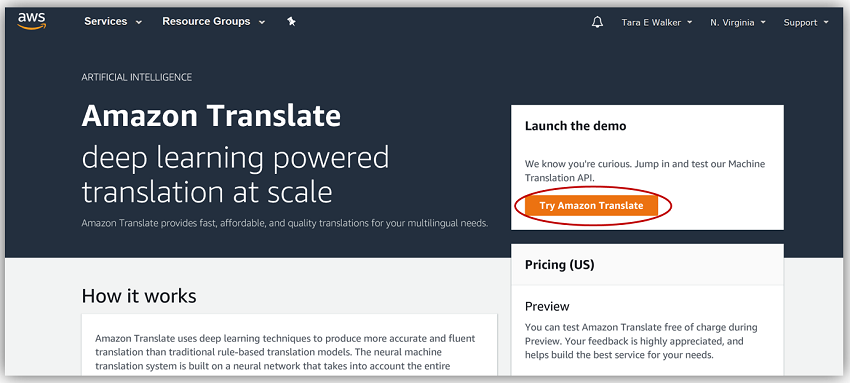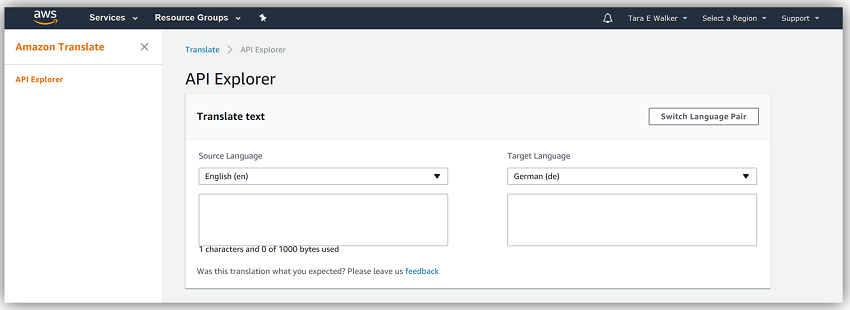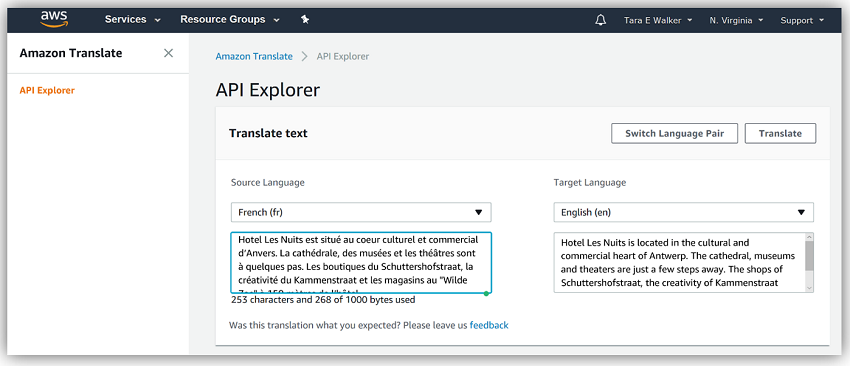AWS News Blog
Introducing Amazon Translate – Real-time Language Translation
|
|
With the advent of the internet, the world has become a much smaller place. Loads of information can be stored and transmitted between cultures and countries within a blink of an eye, giving us all the ability to learn and grow from each other. In order for us to take advantage of all of these powerful vehicles of knowledge and data transfer, we must first break through some of the language barriers that may prevent information sharing and communication.
Outside of being multilingual, one of the ways we can break through these barriers is by leveraging machine translation and related technologies to translate between the languages. Machine translation technologies stem from the computational linguistics field of study that focuses on using software to translate text or speech from one language to another. The concept of machine translation dates back to 1949 when Warren Weaver, an American scientist and mathematician, created the Memorandum on Translation at the request of colleagues from the Division of Natural Sciences at the Rockefeller Foundation to share his language translation ideas. Since then, we have come a long way in the field of machine language translation by using neural networks to enhance the efficiency and quality of translation methods. It should, therefore, be no surprise that the field’s technical progression has led us to the exciting new service I want to introduce to you today.
Let’s Welcome: Amazon Translate
Join me in welcoming the Amazon Translate service to the Amazon Web Service family. Amazon Translate is a high-quality neural machine translation service that uses advanced machine learning technologies to provide fast language translation of text-based content and enable the development of applications that provide multilingual user experiences. The service is currently in preview and can be used to translate text to and from English and the supported languages.
With the Translate service, organizations and business now have the ability to expand products and services in other regions more easily by allowing consumers to access websites, information, and resources in their preferred language using automated language translations. In addition, customers can engage in multiplayer chats, gather information from consumer forums, dive into educational documents, and even obtain reviews about hotels even if those resources are provided in a language they can’t readily understand.
If you are like me, you may be curious about how Amazon Translate works to provide quality machine language translation. Based on deep learning technologies, Translate uses neural networks to represent models trained to translate between language pairs. The model consists of an encoder component which reads sentences from the source language and creates a representation that captures the meaning of the text provided. The model also has a decoder component that formulates a semantic representation used to generate a translation of the text from the source language to the target language. In addition, attention mechanisms are used by the service to build context from each word of the source text provided in order to decide which words are appropriate for generating the next target word. The concept of attention mechanisms in deep learning means that the neural network focuses on the relevant context of source inputs by taking into account the entire context of the source sentence, as well as everything it has generated previously. This process helps to create more accurate and fluent translations.
Amazon Translate can be used with other AWS services to build a robust multilingual experience or enable language-independent processing. For example, the Translate service can be used with some of the following services:
- Amazon Polly: take translated text and provide lifelike speech and allow creation of applications that speak
- Amazon S3: provides the ability to create translated document repositories
- AWS Elasticsearch: create multi-language search using the managed Elasticsearch engine
- Amazon Lex: build a translation chatbot using text and voice
- AWS Lambda: enable localization of dynamic website content
These are just a few examples, but there are many possible solutions that can be enabled by pairing Translate with other AWS Services. Let’s take a quick look at the console and try out the service preview.
When I log into the console, I am presented with lots of great information. I can review information detailing how the Amazon Translate service works including examples, guidelines, and resources around the service and its API.

Since I am very excited to try out this new service, there is no time like the present. I’ll click Try Translate button and go into the API Explorer section of the service.

Since I believe I’m already pretty fluent in English, I’ll switch the language pair to have the Source Language as French (fr) and the Target Language as English (en). I’ll take some verbiage from the French-based hotel’s website I stayed in while in Belgium working a couple of weeks ago.
After pasting the French text from the website into the Translate service to translate it to English, I was pleasantly surprised to find that the translation was not only quick but accurate.

Summary
I am excited to have had the opportunity to provide to you all with an introduction of the new neural-machine translation service, Amazon Translate. With the service, you can translate text to and from English across the breadth of supported languages in real-time. The service is slated to be used directly via the AWS API, CLI, and/or supported SDKs.
Sign up for the Amazon Translate preview today and try the translation service. Learn more about the service by checking out the preview product page or reviewing the technical guides provided in the AWS documentation.
– Tara
